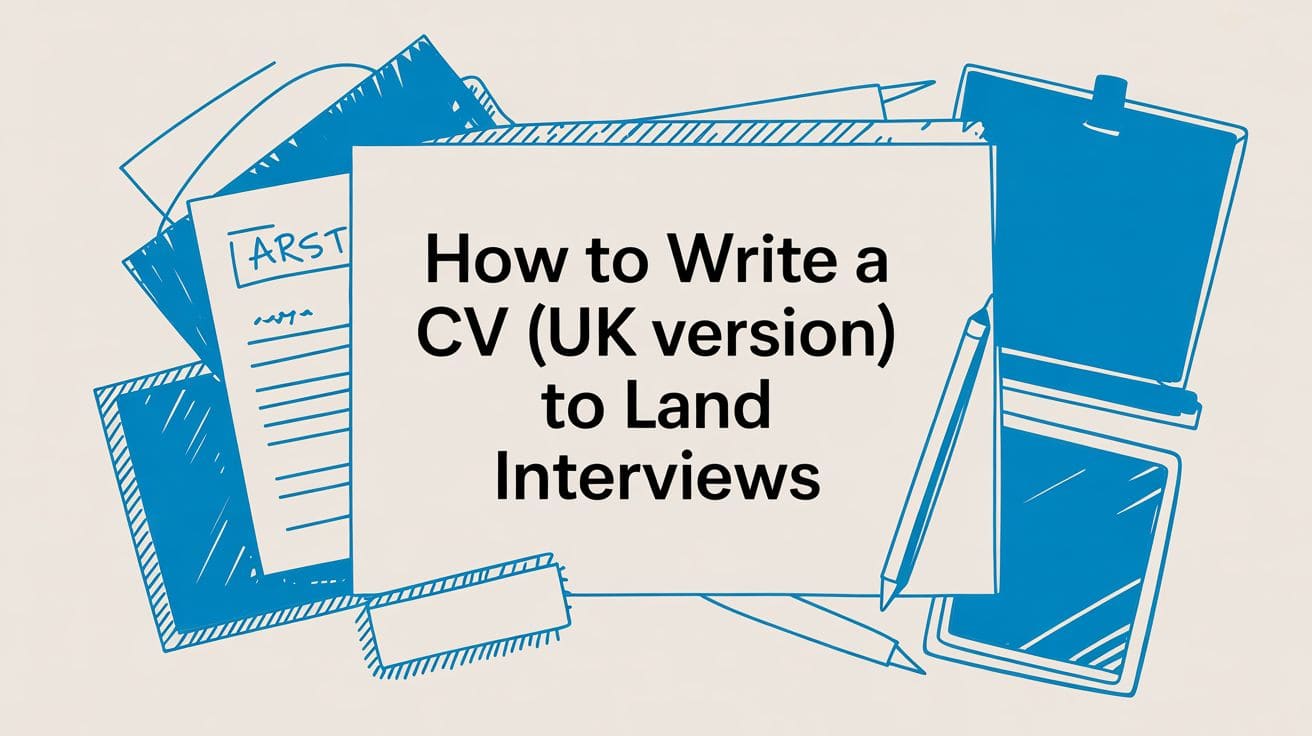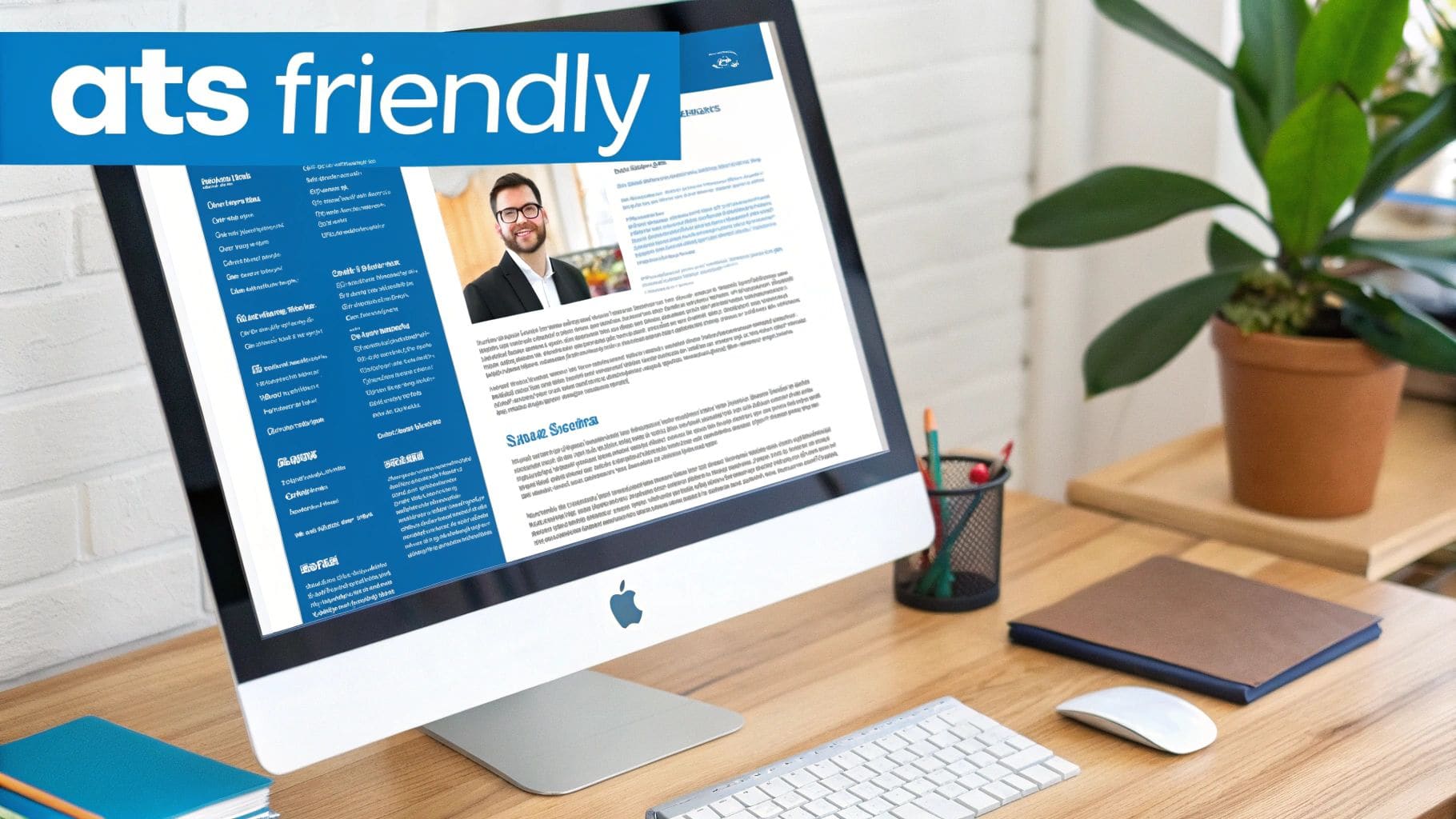How to write a CV (UK version) to land interviews
How to write a CV (UK version) that gets noticed in the UK job market. Learn format, keywords, and essential sections to land interviews.

Learning how to write a CV (UK version) that gets you noticed means thinking like a UK recruiter. They spend, on average, just seven seconds scanning each application. Your job is to make those seconds count with a clean, professional structure that's instantly scannable. The gold standard here is the reverse-chronological format. It's what recruiters expect to see, and it puts your most recent—and usually most relevant—experience right at the top where it belongs.
Structuring Your CV for UK Recruiters

The foundation of any strong UK job application is a well-organised CV. Forget flashy designs or unusual layouts for a moment; what really gets you noticed is clarity and professionalism. The goal is simple: present your career story in a way that's effortless for both a human recruiter and an Applicant Tracking System (ATS) to read.
This comes down to following a few non-negotiable standards. The most important is that reverse-chronological format, where your work history starts with your current or most recent role and works backwards. It's the fastest way to show a hiring manager you've got what it takes.
The Two-Page Rule
In the UK, the golden rule is to keep your CV to a maximum of two A4 pages. This isn't just a casual suggestion; it's a firm expectation from recruiters.
A CV that spills onto a third page can signal that you struggle to prioritise information. On the flip side, a one-page CV might not provide enough depth, especially if you have several years of experience under your belt. Two pages is the sweet spot.
Here's a quick summary of what good UK CV formatting looks like.
UK CV Format At a Glance
| Element | UK Standard | Why It Matters |
|---|---|---|
| Length | Maximum of two A4 pages. | Recruiters expect concise documents. More than two pages suggests you can't summarise your key achievements effectively. |
| Format | Reverse-chronological (most recent role first). | Immediately shows hiring managers your most relevant and current experience, making their job easier. |
| Font | Clean and professional (e.g., Calibri, Arial). | Ensures readability on screen and in print. A simple font choice removes distractions and looks professional. |
| Font Size | 10-12 points for body text. | Large enough to be easily legible without straining the eyes, but small enough to fit your information onto two pages. |
| White Space | Ample margins and spacing between sections. | Prevents a "wall of text" effect, making your CV scannable and allowing key information to stand out. |
Sticking to these rules isn't about being boring; it's about making sure your experience is the star of the show, not your formatting choices.
Creating a Clean and Scannable Layout
Visual appeal in a UK CV comes from simplicity, not complexity. Your font choice and use of white space are absolutely critical for readability.
Stick to professional, clean fonts like Calibri, Arial, or Helvetica in a size between 10 and 12 points. These are easy on the eyes and are standard across most systems, so you won't run into any weird formatting issues.
Using plenty of white space around your text and between sections is just as important. It breaks up the content and stops your CV from looking like an intimidating block of text, guiding the recruiter's eye to the information that matters most. For more ideas, you can explore some modern resume formats.
Your CV's structure is its silent sales pitch. A clean, logical layout tells a recruiter you are organised, professional, and respectful of their time—qualities that are universally valued.
Focusing on Achievements Over Duties
One of the most common mistakes I see is people simply listing their job duties. A CV full of phrases like "Responsible for managing social media" just doesn't cut it. You need to show your impact.
Think about what you actually accomplished in that role. For instance, I once helped a client rephrase that exact point. We turned it into: "Increased social media engagement by 30% over six months by implementing a new content strategy and A/B testing post formats." See the difference? One is a passive description; the other is a powerful, measurable result.
For each role, aim for 2-4 powerful, achievement-orientated bullet points. Kick things off with a strong action verb (like 'managed,' 'developed,' or 'launched') and back it up with numbers, percentages, or specific outcomes whenever you can. This shift from listing duties to showcasing achievements is what separates a good CV from a great one.
Get your free CV review
Upload your CV and get instant AI suggestions to improve your chances
Building the Core Sections of Your UK CV

Once your structure is sorted, the real work begins: filling it with compelling content. This is the part of learning how to write a CV (UK version) that separates a simple list of facts from a persuasive pitch for an interview.
Each section has a specific job to do, and getting them right is what builds a powerful narrative about your professional journey. It's about being strategic, aligning with UK hiring norms, and making sure every single line earns its place on the page.
Starting with Your Contact Details
This might sound obvious, but getting it wrong can be an instant red flag. Your contact information needs to be clean, professional, and impossible to miss right at the top of the page. It's the first thing a recruiter looks for when they want to get in touch, so don't make them hunt for it.
Crucially, UK etiquette is very specific about what you should and shouldn't include here to avoid unconscious bias. Stick to the absolute essentials.
What to include:
- Full Name: Presented clearly and boldly at the top.
- Phone Number: Your mobile number is best.
- Professional Email Address: Keep it simple, like
firstname.lastname@email.com. - Location: Just your town and the first part of your postcode is enough (e.g., Manchester, M1). No need for your full street address.
- LinkedIn Profile URL: Make sure your profile is complete, professional, and up-to-date.
You must leave out personal details that are common on CVs in other countries. That means no photo, no date of birth, no nationality, and definitely no marital status. Including these is a classic mistake that signals you haven't researched UK norms.
Crafting a Powerful Personal Profile
Your Personal Profile (often called a Personal Statement) is your hook. It's a short, punchy paragraph of 3-5 lines sitting just below your contact details, and its only job is to convince the reader to keep going.
Think of it as your professional elevator pitch. This isn't a generic, fluffy objective; it needs to be tailored to the specific job you're applying for, immediately highlighting your most relevant experience and skills.
A strong personal profile bridges the gap between your past experience and the future role you want. It answers the recruiter's primary question: "Why are you the right person for this job?"
To nail this, you need to dissect the job description and mirror its language and priorities. For a more detailed walkthrough, read our guide on how to write a CV personal statement.
Detailing Your Employment History
This is the heart of your CV—the section where you prove your value through past wins. As mentioned earlier, list your roles in reverse-chronological order. For each position, you'll need your job title, the company name, its location, and the dates you worked there.
The real magic, however, happens in the bullet points. Don't just list your duties; showcase your achievements. Start every point with a strong action verb (like 'managed', 'developed', or 'slashed') and, wherever possible, back it up with hard numbers.
Example: From Duty to Achievement
- Instead of: "Responsible for managing the company's social media accounts."
- Write: "Grew social media following by 40% across three platforms by developing and executing a new data-driven content strategy."
That small tweak shifts the entire focus from what you did to the impact you made. That's what gets you noticed.
Presenting Your Education and Skills
How you handle your Education section really depends on where you are in your career. If you're a recent graduate, it should be front and centre, right after your Personal Profile. For seasoned professionals with years of experience, it can sit comfortably after your Employment History. List qualifications in reverse-chronological order.
Finally, your Skills section acts as a quick, scannable summary of your key capabilities. This is prime real estate for both recruiters and the ATS bots. To make it effective, split it into logical categories.
- Technical Skills: Get specific. List software, programming languages, or platforms you're proficient in (e.g., Python, Adobe Creative Suite, Google Analytics).
- Soft Skills: Include core competencies like Communication, Teamwork, Problem-Solving, and Leadership. Just remember to back these claims up with evidence in your Employment History.
A well-structured Skills section doesn't just repeat information; it reinforces the story you've told throughout the CV, giving the recruiter one last, compelling reason to pick up the phone. Getting this balance right is a crucial part of learning how to write a CV (UK version) that actually opens doors.
Beating the Bots with an ATS-Friendly CV

Before your CV ever lands in front of a hiring manager, it has a digital gatekeeper to get past. This is the Applicant Tracking System (ATS), a piece of software that scans, filters, and ranks applications based on how well they match the job description.
This is a massive hurdle most people don't even think about. But if you want to know how to write a CV (UK version) that actually gets you an interview, you have to realise your first audience isn't a person—it's an algorithm. If the ATS can't read your CV, it's the digital equivalent of it going straight into the bin.
Decoding the Job Description for Keywords
The secret to getting past the ATS is hidden in plain sight: the job description. It's not just a list of duties; it's a blueprint filled with the exact keywords and phrases the machine is programmed to look for. Your job is to find them and sprinkle them strategically throughout your CV.
Start by poring over the job advert, especially the "Responsibilities" and "Requirements" sections. Highlight any recurring words, specific skills, software names, qualifications, or industry jargon. These are your golden tickets.
For instance, a role for a Digital Marketing Manager might keep mentioning:
- SEO strategy
- PPC campaigns
- Google Analytics
- Content marketing
- Team leadership
These are the exact phrases that need to appear in your Personal Statement, Employment History, and Skills sections for the ATS to give you a high score.
Formatting Your CV for the Machines
Fancy formatting is the enemy of the ATS. A creative layout might look brilliant to the human eye, but it can be gibberish to the software. I once worked with a client whose application was repeatedly rejected, and it turned out their work history was in a fancy table the ATS couldn't parse at all.
To avoid that fate, play by these rules:
- Stick to Standard Headings: Use simple, universally understood headings like "Employment History," "Education," and "Skills."
- Avoid Tables and Columns: Most systems read from left to right, line by line. Columns will turn your carefully crafted sentences into a jumbled mess.
- Use Simple Bullet Points: Stick to the classic round or square ones. Avoid arrows, ticks, or other complex symbols.
- Submit the Right File Type: Unless the advert says otherwise, always save and send your CV as a .docx or .pdf. PDFs are usually best for keeping your formatting intact, but some older ATS platforms can still struggle with them.
The most effective ATS-friendly CV is often the simplest. Prioritise clarity and standard formatting over clever design to make sure it's your experience, not your layout, that gets you noticed.
Weaving Keywords Naturally into Your Content
Once you have your keywords, the trick is to work them in without sounding like a robot repeating a script. This is "keyword optimisation," not "keyword stuffing." A real person will (hopefully) read your CV next, and it needs to flow smoothly.
Don't just list them. Instead, embed your keywords into achievement-focused bullet points. For example, if the job requires "stakeholder management," you could write something like: "Successfully managed relationships with key internal and external partners, demonstrating strong stakeholder management to ensure project alignment." It provides context and proves you can do the job.
To truly get your CV past the initial screening, it helps to read a comprehensive explanation of Applicant Tracking Systems and understand exactly how they work.
In the UK job market today, this tailored approach isn't just a good idea—it's essential. Recruiters now expect to see CVs that are specifically adapted for each role, pulling in language directly from the job description. It's the single most effective way to satisfy the ATS and land a callback.
If you'd like to learn more about this process, we have a deep dive into how to write an ATS-friendly resume.
Getting to Grips with UK CV Etiquette
The small details often make the biggest difference, and that's especially true when you're figuring out how to write a CV for the UK market. The British job scene has its own unwritten rules. Something that's perfectly standard in another country can be an immediate red flag here, telling a recruiter you haven't done your homework.
Following this etiquette isn't just about ticking boxes; it's about showing you're a professional who understands the local business culture. Getting these details right proves you're thorough and serious about the role.
What Personal Details to Leave Out
In many parts of the world, popping a headshot on your CV is the norm. In the UK, it's a firm no. UK employers are bound by strict equality and anti-discrimination laws, so including a photograph, your date of birth, nationality, or marital status comes across as unprofessional.
Recruiters actively screen this information out to ensure the hiring process is fair. Including it just makes their job harder and could get your CV binned to avoid any hint of bias. The focus must be squarely on your skills and experience.
Spelling and Tone of Voice
Consistency is key. Your CV must use UK English spelling all the way through—think 'organise' instead of 'organize' and 'analyse' instead of 'analyze'. Mixing US and UK English looks sloppy and suggests you don't pay attention to detail.
Your tone needs to hit that sweet spot between professional and approachable. Avoid overly stiff, academic language, but don't be too casual either. You're aiming for a confident, clear, and direct voice that sells your value without sounding arrogant.
A CV that follows UK etiquette does more than just look right; it shows cultural awareness and a genuine effort to meet professional standards—qualities every employer looks for.
The Right Way to Handle References
Another point of confusion is often references. Unlike in some countries where you might list your referees and their contact details directly on your CV, the UK standard is much simpler.
The professional norm is to add one simple line at the very end of your CV: "References available upon request." That's it. Recruiters know this means you have people ready to vouch for you and will ask for their details when the time is right, usually after a successful interview.
To see how all these pieces fit together in practice, checking out some well-made UK CV templates and examples can make things much clearer.
UK CV vs International CV Key Differences
To help you sidestep some common blunders, here's a quick rundown of standard UK practices versus what you might see on an international CV or a US résumé. Nailing these distinctions is a huge part of understanding how to write a CV that connects with UK hiring managers.
| Feature | UK Standard | Common International Practice |
|---|---|---|
| Photograph | Never include a photo. | Often included, especially in parts of Europe and Asia. |
| Personal Data | Omit age, DoB, marital status, nationality. | May include date of birth, marital status, or even number of children. |
| Length | Strictly 1-2 A4 pages. | Can vary; academic CVs can be longer, US résumés often stick to one page. |
| Terminology | Always called a "CV." | "Résumé" is the common term in the US and Canada. |
| References | State "Available upon request." | Sometimes listed directly on the document with contact details. |
| Spelling | UK English (e.g., 'colour', 'organise'). | Varies by region (e.g., US English: 'color', 'organize'). |
By taking these differences on board, you make sure your CV won't be dismissed for an easily avoidable cultural slip-up. This thoughtful approach shows your professionalism and respect for the way things are done in the UK job market.
Turning Employment Gaps into Strengths

Let's be honest: employment gaps happen. The good news is that they are no longer the red flag they once were for UK recruiters. If you're learning how to write a CV (UK version), the key isn't to hide a gap but to own it and show you were productive.
Whether you were travelling, caring for family, studying, or just taking a much-needed break, that time can be framed as a period of genuine growth. Your goal is to control the narrative and demonstrate your proactive mindset to a potential employer.
Reframe Your Career Break
Leaving a blank space on your CV is an invitation for assumptions. The best approach is to address the gap head-on with its own dedicated section, transforming a potential weakness into a structured, positive part of your story.
You can do this simply by creating a new heading, just like "Employment History," to account for the time. This keeps your timeline clear and, more importantly, shows confidence.
A few strong examples for headings include:
- Professional Development (perfect if you were studying or gaining certifications)
- Career Break for Family Commitments (clear and professional for caregiving)
- Voluntary Work & Travel (great for combining volunteering or exploration)
Under this new heading, use a couple of bullet points to explain what you did and, crucially, what you gained from the experience.
Don't ever apologise for a career gap. Instead, present it as a deliberate and productive chapter in your professional life. Focus on the skills you maintained or developed during that time.
Showcase Skills Gained During Your Time Off
Every experience, even outside of a traditional job, gives you valuable skills. The trick is to identify them and connect them directly to the role you're applying for.
For instance, if you were travelling, you undoubtedly honed skills in budgeting, planning, and cross-cultural communication. If you were caring for a family member, you almost certainly sharpened your time management, problem-solving, and organisational abilities.
Did you take on any freelance or self-employed work? This is a fantastic opportunity to showcase your initiative and business sense. You can find some excellent advice on how to properly list self-employment on your CV to make it really stand out.
The Growing Acceptance of Employment Gaps
UK recruiters are more accustomed to seeing career breaks on CVs than ever before. In fact, a comprehensive report from LiveCareer revealed that nearly a quarter of UK job seekers had an employment gap of 12 months or more, a significant increase from previous years.
This shift means that the best advice on how to write a CV (UK version) now actively encourages candidates to address these periods constructively. Highlighting any upskilling, voluntary work, or relevant life experience is now seen as the mark of a well-rounded and resilient candidate.
Got a Question About Your UK CV?
Once you've got the main sections of your CV drafted, it's often the little details that cause the most head-scratching. Getting these final touches right is crucial for making sure your document feels polished, professional, and perfectly in line with what UK recruiters expect to see.
Let's clear up some of the most common questions job seekers have when finalising their applications.
Do I Really Need a Cover Letter with My UK CV?
Yes, you almost always do. Unless a job advert specifically says "no cover letters," you should assume it's a mandatory part of your application in the UK. Don't think of it as an optional extra; it's a vital piece of the puzzle.
Your CV is the "what" – it lists what you've done and the skills you have. The cover letter is your "why" – it explains why you're the right person for this specific job and why you want to work for this particular company. It's your one chance to show some personality and connect your experience directly to the employer's needs in a way your CV just can't.
Your CV gets you on the longlist; your cover letter gets you on the shortlist. Never miss the opportunity to submit both unless explicitly told otherwise.
What's the Difference Between a CV and a Resume in the UK?
This one's simple: in the UK, we use the term "CV" (Curriculum Vitae) for all job applications. Whether you're a recent graduate or a CEO, it's a CV. The word "resume" is an Americanism and is almost never used here.
The difference goes beyond the name, though. A UK CV is typically more detailed than a standard one-page US resume. The standard length is two full A4 pages. This gives you the space to provide a more thorough account of your work history and achievements, which is exactly what UK hiring managers are looking for. Using the word "resume" can be an instant giveaway that you're not familiar with local hiring norms.
Is It Okay to Use a Creative or Infographic CV?
This is a great question, and the answer really depends on your industry. For the vast majority of jobs—think finance, law, engineering, or administration—stick to a traditional, professional format. These sectors value clarity and substance over creative flair. A simple, clean layout ensures your skills and experience are the star of the show.
However, if you're applying for a role in a creative field like graphic design, marketing, or media, a more visual CV can be a brilliant way to showcase your abilities.
Even then, a word of caution: make sure it's still easy to read and, most importantly, ATS-friendly. When in doubt, a clean, professional, and traditionally formatted document is always the safest bet.
Once your perfectly formatted UK CV has landed you that interview spot, your next step is mastering how to prepare for an interview. Nailing that is the final piece of the puzzle.
Ready to create a standout CV without the hassle? CV Anywhere's Smart CV Builder helps you craft a polished, ATS-friendly document in minutes. Our tools analyse job descriptions to ensure you have the right keywords, track all your applications in one place, and even help you practise for interviews. Move from application to offer faster at https://cvanywhere.com.
Tags
Related Articles
How to Create a CV That Actually Gets Noticed
A Curriculum Vitae, or CV, is supposed to be your professional story, the one document powerful enough to land you an interview. But let's be real—for many incredibly qualified people, that document e...
Read more →Create a Winning CV | Expert Tips & ATS Optimization for 2025
A CV, or Curriculum Vitae, is the comprehensive story of your professional and academic life. Think of it not as a simple summary, but as a detailed, multi-page document that chronicles your entire ca...
Read more →Your Guide to a Modern Format of Resume
A modern format of resume strikes a crucial balance between a clean, professional design that's easy for a human to read and a structure that's perfectly optimised for Applicant Tracking Systems (ATS)...
Read more →Popular Articles
Learning how to write a CV (UK version) that gets you noticed means thinking like a UK recruiter. They spend, on average, just seven seconds scanning each application. Your job is to make those second...
A modern format of resume strikes a crucial balance between a clean, professional design that's easy for a human to read and a structure that's perfectly optimised for Applicant Tracking Systems (ATS)...
A thorough resume review is the first line of defence, catching common slip-ups that get applications tossed aside. This checklist ensures your CV meets professional standards before it goes under the...
Preparing for the most common behavioural interview questions is the single best way to demonstrate your competence, problem-solving skills, and cultural fit. Unlike technical questions that test what...
A professional CV is a comprehensive dive into your career history, skills, and qualifications, designed to give potential employers the full picture of your expertise. Unlike a shorter resume, it det...